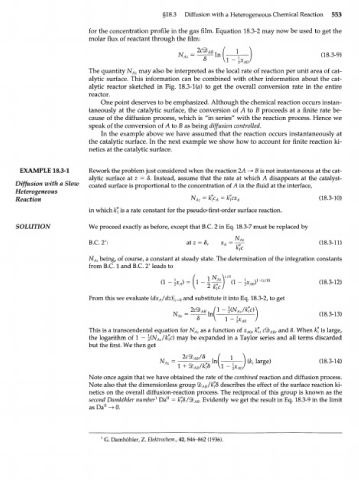Page 573 - Bird R.B. Transport phenomena
P. 573
§18.3 Diffusion with a Heterogeneous Chemical Reaction 553
for the concentration profile in the gas film. Equation 18.3-2 may now be used to get the
molar flux of reactant through the film:
1
N Az = AB In (18.3-9)
The quantity N Az may also be interpreted as the local rate of reaction per unit area of cat-
alytic surface. This information can be combined with other information about the cat-
alytic reactor sketched in Fig. 18.3-1 (a) to get the overall conversion rate in the entire
reactor.
One point deserves to be emphasized. Although the chemical reaction occurs instan-
taneously at the catalytic surface, the conversion of Л to В proceeds at a finite rate be-
cause of the diffusion process, which is "in series" with the reaction process. Hence we
speak of the conversion of Л to В as being diffusion controlled.
In the example above we have assumed that the reaction occurs instantaneously at
the catalytic surface. In the next example we show how to account for finite reaction ki-
netics at the catalytic surface.
EXAMPLE 18.3-1 Rework the problem just considered when the reaction 2A —> В is not instantaneous at the cat-
alytic surface at z = 8. Instead, assume that the rate at which A disappears at the catalyst-
Diffusion with a Slow c o a ted surface is proportional to the concentration of A in the fluid at the interface,
Heterogeneous
Reaction N Az = k"c = k"cx A (18.3-10)
A
in which k" is a rate constant for the pseudo-first-order surface reaction.
SOLUTION We proceed exactly as before, except that B.C. 2 in Eq. 18.3-7 must be replaced by
N
B.C. 2': at z = x A = • Az (18.3-11)
N Az being, of course, a constant at steady state. The determination of the integration constants
from B.C. 1 and B.C. 2' leads to
iy
(л 1 \ _ I -i 1 Az \ n l 4l-(z/5) (18.3-12)
From this we evaluate (dx /dz)\ = and substitute it into Eq. 18.3-2, to get
A
z
0
"AB
N = lni (18.3-13)
A
X
2 A
This is a transcendental equation for N Az as a function of x , к", сЯЬ , and 8. When k" is large,
АВ
A0
the logarithm of 1 - l(N /k"c) may be expanded in a Taylor series and all terms discarded
Az
but the first. We then get
N A = lnl (k large) (18.3-14)
® AB /k"8 VI - \ }
Note once again that we have obtained the rate of the combined reaction and diffusion process.
Note also that the dimensionless group ЯЬ /к"8 describes the effect of the surface reaction ki-
АВ
netics on the overall diffusion-reaction process. The reciprocal of this group is known as the
second Damkdhler number^ Da = k"8/%b . Evidently we get the result in Eq. 18.3-9 in the limit
11
AB
as Da -> 0.
11
1 G. Damhohler, Z. Elektrochem., 42, 846-862 (1936).

